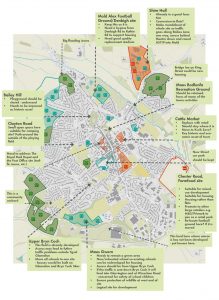Place Plans may not be the best-known mechanism for community-led planning but, says David Edwards of architects and urban planners Place-Make, their flexible, collaborative nature make them a valuable tool for planners and residents alike
The Localism Act of 2011 brought greater opportunities for community-led planning and for residents to influence their physical and social environments. Neighbourhood Plans are being prepared for towns, cities and villages across the UK. According to the Ministry of Housing, Communities & Local Government (MHCLG), up to 700 plans have now been adopted and are currently being used to determine major planning applications and influence strategic planning.
Perhaps a lesser known mechanism for community-led planning is a Place Plan – having been used effectively in Wales since 2015, these are now beginning to gain traction across the UK. While Neighbourhood Plans are statutory documents with the same status as a Local Plan, Place Plans are advisory, adopted as supplementary planning guidance (SPG). As such, they present a varying offering to the Neighbourhood Plan that can benefit local authorities and residents alike.

The main difference stems from their designations. As statutory documents, the adoption of a Neighbourhood Plan involves an inspection by an independent adviser and a community-wide referendum. However, as SPGs, Place Plans can be approved by the local authority, thereby ensuring a quicker delivery and providing greater flexibility for use across different plan periods. Additionally, there are fewer restrictions binding Place Plans to the Local Plan and Core Strategy, thereby allowing stakeholders to have a greater input from the outset.
Plans that are currently adopted consider a wide variety of study areas, from city centres, towns and villages to allocated and potential sites. In the case of the latter, the plan might take the form of a Development/Design Brief outlining predominant opportunities and constraints. Such site-specific plans allow stakeholders the opportunity to impart into the design process at an early stage and provide as a guide for the design team and the local authority when preparing and determining applications. Additionally, the preparation of a Place Plan involves the collective input of local residents, business owners, authority case officers and potential developers in a collaborative manner.
The Welsh Government’s 2015 Planning Act gives a particular weight to Place Plans, requiring LPAs to work with communities to prepare their plans, the principle intent being that plans are “written by local people who know the area well and can add more detail to the work done by the planners” (www.placeplans.org).

Part of the success of Place Plans in Wales must surely be attributed to the style and nature of advisory material that has been made available by the Welsh Government, which includes toolkits for establishing steering groups, applying for funding, gathering evidence and formulating the plan. This involves a checklist of aspects that might be considered, ranging from housing needs, supporting activities and the identification of potential sites to circulation, wayfinding and character.
It is interesting to note that outside of Wales, adopted Place Plans are predominantly in border counties (Shropshire, Cheshire and Somerset), which suggests that communities and authorities have been quick to realise their value. For me, they certainly have a role as flexible advisory documents that provide invaluable place-specific and community-led layers of information to statutory material.
David Edwards
Director
Tel: +44 (0)1462 510 099
Twitter: Place_make
Facebook: PlaceMake
LinkenIn: Place-make
















